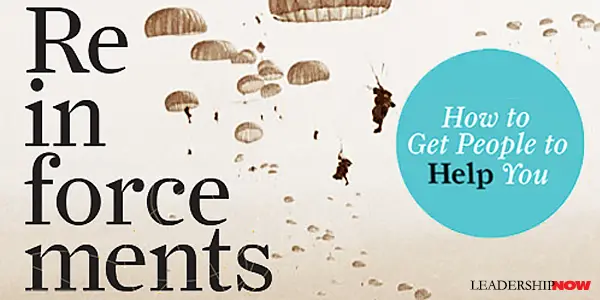 |
 |
06.08.18

Reinforcements: How to Get People to Help You
“I actually felt as if I was going to perish,” said psychologist Stanley Milgram upon asking a subway rider for their seat. Asking for help makes most of us uncomfortable and we often go to great lengths to avoid doing it. We fear rejection. We fear that people we think less of us. We believe people don’t really want to help. But the truth is we need the help and support of others to succeed. To be sure, leadership is fundamentally about asking people for help. “Reaching your fullest potential—professionally or personally—requires you to understand how to enlist reinforcements when you need them. For many of us, ‘when you need them’ is literally every day,” writes Heidi Grant in Reinforcements. Yet our reluctance to ask for help means we often don’t get the support or the resource we need. Making matters worse, our intuitions about what should make others more likely to help are often dead wrong; our fumbling, apologetic ways of asking for assistance generally make people feel far less likely to want to help. We hate imposing on people and then inadvertently, we make them feel imposed upon. We underestimate our chances of getting help, especially from those that have said “no” once already. We don’t like saying “no.” We don’t think less of people when they ask us for help. But for some reason, we forget that when it is our turn to ask for help. Research shows that people actually like us more when they have been able to help us. It makes them feel good too—unless they feel compelled to help. Asking someone, “Can you do me a favor?” increase the likelihood that they’ll say yes, but usually because they now feel trapped. So what are the subtle cues that motivate people to work for us? Grant says, first of all, don’t make it weird by overdoing it on empathy (i.e., ASPCA commercials), apologizing profusely (just ask), using disclaimers (“I normally wouldn’t…”), emphasizing how much the other person will love helping (“This will be fun!”), and reminding people that they owe you one, among other tactics. Instead try these three ways of asking others for help: In-Group Reinforcement Those members of our group are the most likely to help us. To create a sense of in-group among people, use the word “together,” create or highlight shared goals, identify a common enemy, share common emotions, experiences, and feelings. The Positive Identity Reinforcement Most people like to think of themselves as helpful because it is part of what it means to be a good person. We reinforce that with gratitude and appealing to the things that matter to them. “To maximize positive identity reinforcement, know your audience and emphasize what matters to them, not to you.” Gratitude is a glue that binds you and your benefactor together, allowing you to hit the same well over and over again when you need support, know that it won’t run dry. Also, “the more unique the help, the more closely tied it is to who they are.” If people feel that anyone could help you, it is more likely that they will pass thinking that someone else will help. They need not bother. “To activate the positive identity reinforcement, find ways to convey that the helper is in a unique position to help you.” “You’re my only hope.” The Effectiveness Reinforcement People want what they do to make an impact—to have meaning. If we feel we are not making an impact, we are likely to lose motivation. People need to clearly understand the impact of their helping. Research shows that when people are unable to get any kind of feedback about how well they are doing on a task, they quickly become disengaged from it. The question is, “How do I know what I am doing is important?” “How do I know that my time, money, or effort wouldn’t be better spent some other way?” Be clear up-front about what you want done and the impact it will have. And be sure to follow-up. Let them know how things turned out. As a leader, “helping people see the impact of their work—their help—is one of the most important motivators you can wield.” Reinforcements is written in an engaging way and is full of solid research to support the approach needed to get the help we need to succeed. It is practical advice for anyone asking for help in a way that will leave both parties feeling good about the relationship. 
Posted by Michael McKinney at 07:41 AM
|
BUILD YOUR KNOWLEDGE
 

How to Do Your Start-Up Right STRAIGHT TALK FOR START-UPS 
Grow Your Leadership Skills NEW AND UPCOMING LEADERSHIP BOOKS 
Leadership Minute BITE-SIZE CONCEPTS YOU CAN CHEW ON 
Classic Leadership Books BOOKS TO READ BEFORE YOU LEAD |